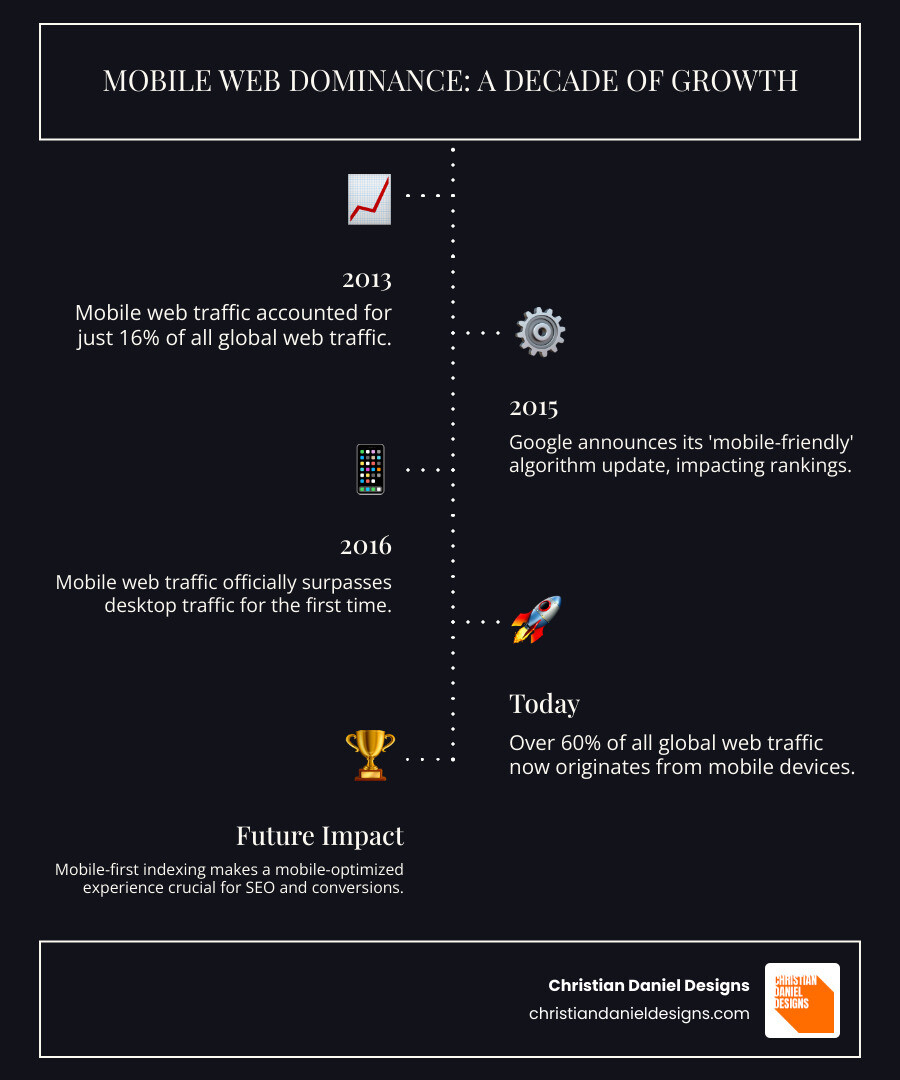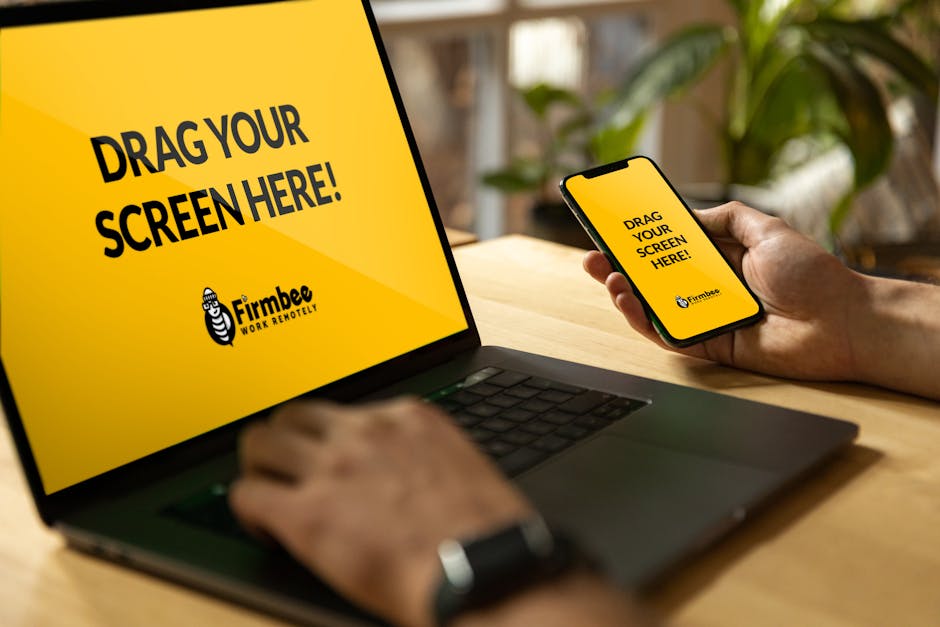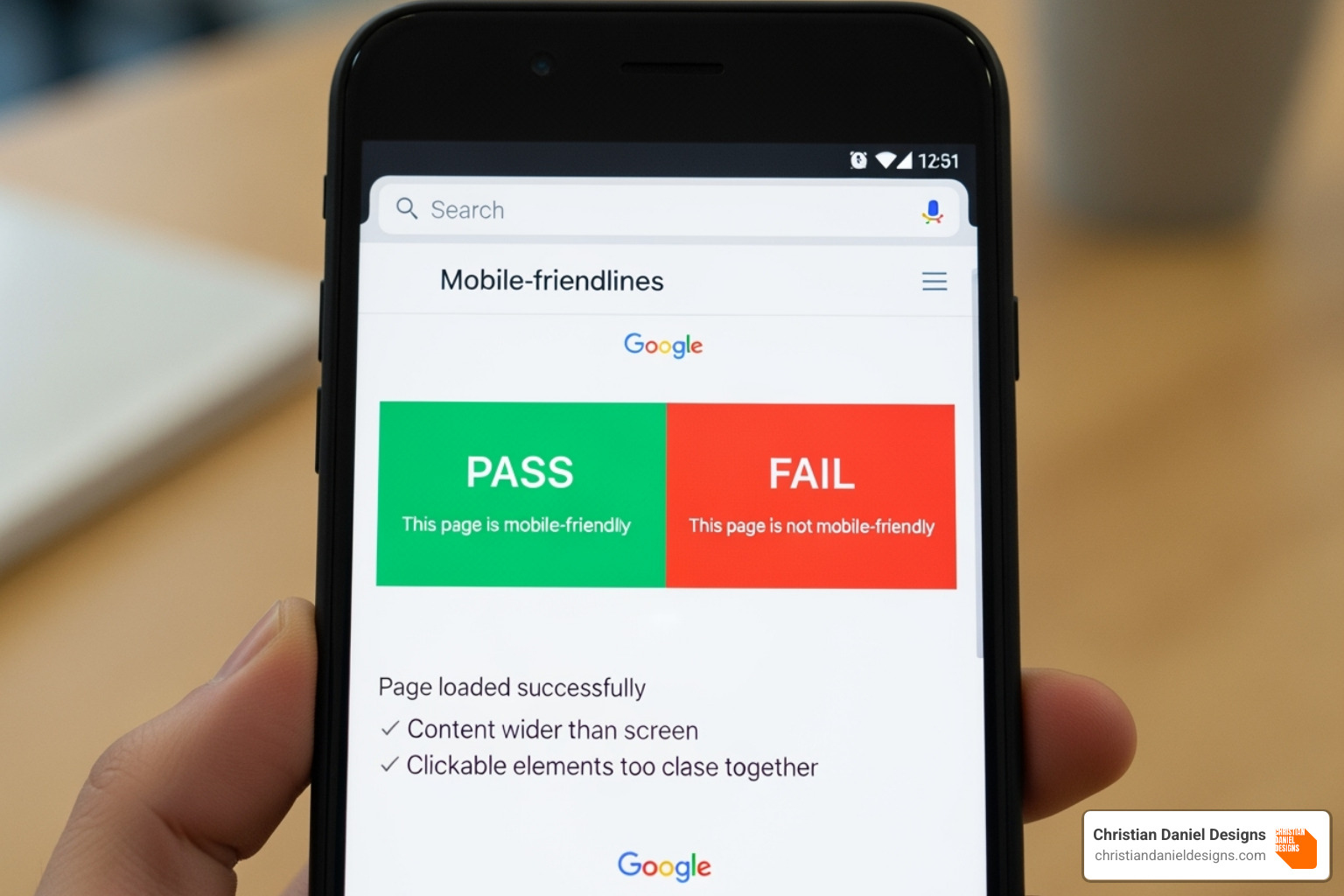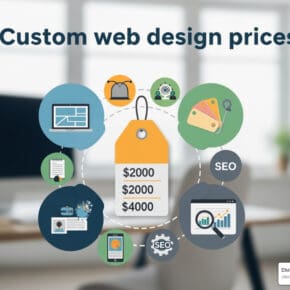Why Your Website Must Be Mobile-Friendly in 2025
Mobile friendly website design ensures your site works flawlessly on smaller screens. With over 60% of all web traffic now coming from mobile devices, it’s no longer optional—it’s essential for reaching your audience and staying competitive.
Key elements of mobile friendly website design:
- Responsive layout that adjusts to any screen size
- Fast load times under 3 seconds
- Large, tappable buttons (minimum 44×44 pixels)
- Simplified navigation with hamburger menus
- Readable text without zooming (16px minimum)
- Touch-friendly forms with minimal fields
- No Flash or hover-dependent features
The stakes are high. Visitors are 5 times more likely to leave if your site isn’t mobile-friendly. Google’s mobile-first indexing means your mobile site directly impacts your search rankings. And customers are 67% more likely to make a purchase on a mobile-friendly site.
Mobile traffic surpassed desktop in 2016 and continues to grow. If your website fails on a potential customer’s phone, you’ve lost them to a competitor. Fortunately, creating a mobile-friendly site is straightforward: prioritize speed, simplify navigation, and design for thumbs.
I’m Christian Daniel, founder of Christian Daniel Designs. For over two decades, I’ve helped hospitality, dining, and creative brands build mobile-friendly websites that drive real results.

What is a Mobile-Friendly Website?
A mobile-friendly website provides a seamless experience on any device, from smartphones to tablets. The layout, content, and features automatically adapt to the screen size, eliminating the need to pinch, zoom, or scroll horizontally. Text is legible, images scale correctly, and buttons are easy to tap, ensuring a positive user journey.
The Business Case: More Traffic, Better Engagement
Embracing mobile friendly website design offers tangible business benefits:
- Increased Reach: With over half of Google searches and 55.79% of global web traffic on mobile, an optimized site is crucial for reaching a massive audience.
- Higher Conversion Rates: A good mobile experience boosts your bottom line. Customers are 67% more likely to buy, and fast-loading sites see 2.5 times higher conversion rates.
- Improved Brand Perception: A slick mobile site builds credibility and trust. 74% of users are more likely to return to a mobile-friendly site, fostering brand loyalty.
- Competitive Advantage: Many businesses still lag in mobile optimization. Prioritizing it gives you a significant edge over the competition.
The Impact of Google’s Mobile-First Indexing on Your SEO
Mobile-friendly design is critical for SEO because of Google’s mobile-first indexing. Google now judges your entire website based on its mobile version. When crawlers visit your site, they look at the mobile version first to determine rankings, even for desktop searches. If your mobile site is slow, clunky, or missing content, your rankings will suffer on all devices.
This reflects user behavior, as mobile searches have long surpassed desktop. Mobile users need quick answers and a smooth, thumb-driven experience. If your site doesn’t provide this, Google knows it’s a poor user experience and will rank you lower.
Google started favoring mobile-friendly sites in 2015 and made mobile-first indexing the standard by 2019. The message is clear: optimize for mobile or become invisible.
You can dive deeper into Google’s technical requirements in Google’s official guide to mobile-first indexing.
Understanding Mobile-First Indexing
Mobile-first indexing means Google uses your mobile site as the “real” version for indexing and ranking. If content exists on your desktop site but not your mobile site, Google may not see it at all. This makes content parity between desktop and mobile versions essential. You can’t offer a stripped-down mobile site and expect to rank well.
How a Poor Mobile Experience Hurts Your Rank
A website that doesn’t work well on mobile actively sabotages your search rankings in several ways.
Lower rankings are the most direct consequence. A poor mobile experience signals a low-quality site to Google, directly lowering your search rankings across the board.
Reduced visibility means your site may not even appear in some mobile search results if it fails basic mobile-friendliness tests, cutting off organic traffic.
Higher bounce rates from frustrated mobile users signal to Google that your site isn’t meeting their needs. This creates a vicious cycle of ever-lower rankings.
Negative user signals like short session durations and low engagement on mobile are other red flags that tell Google your site isn’t valuable, further hurting your SEO.
Slower page speed penalties hit hard. Page speed is a direct ranking factor, especially for mobile. A slow site suffers a double penalty: users leave, and Google ranks you lower.
In short, a poor mobile experience systematically undermines your entire online presence, making it harder for customers to find you.
Core Principles of Mobile Friendly Website Design

Effective mobile friendly website design isn’t about shrinking your desktop site. It’s a mobile-first mindset that ensures your website works beautifully everywhere. This section covers the core strategies to achieve that.
Accept Responsive Web Design
Responsive web design is the gold standard. It uses a single website that automatically adjusts its layout to fit any screen size, from phones to desktops. This is achieved with fluid grids and flexible layouts that scale smoothly. The magic happens through CSS media queries, which apply different styling rules based on screen width.
Google strongly recommends this approach because it uses a single URL. This simplifies crawling for search engines and consolidates your SEO authority. Unlike older methods with separate mobile sites (e.g., “m.yourdomain.com”), responsive design is more flexible, future-proof, and easier to maintain.
Prioritize Blazing-Fast Load Speeds
On mobile, speed is everything. Google found that 53% of mobile visitors will leave your page if it takes longer than 3 seconds to load. Speed also directly impacts SEO through Core Web Vitals. To achieve these blazing-fast speeds, we focus on a few key strategies:
- Image optimization: Compressing images, using modern formats like WebP, and implementing lazy loading (loading images only as they’re scrolled into view).
- Minify CSS and JavaScript: Removing unnecessary characters from code files to reduce their size.
- Browser caching: Storing files on a user’s device so they load instantly on return visits.
- Reduce HTTP requests: Combining files and eliminating unnecessary elements to speed up server communication.
For a deeper dive, check out Google’s speed recommendations.
Simplify Navigation and Content for Small Screens
Simplifying your site for small screens is crucial. Mobile users need information quickly, so a minimalist approach works best.
- Design for vertical scrolling: Transform multi-column desktop layouts into a single, easy-to-scroll column.
- Make content scannable: Use concise copy, short paragraphs, bullet points, and clear headings. A font size of at least 16px is essential for readability.
- Use a hamburger menu: This standard icon tucks navigation links away, saving screen space. Limit menu items to 4-8 key options.
- Design for thumb-friendly interaction: Place important buttons and navigation within the easy reach of a user’s thumb, typically in the middle or bottom of the screen.
- Maintain a clear visual hierarchy: Use size, color, and contrast to highlight the most important information and calls-to-action.
Best Practices for a High-Converting Mobile Experience
With a responsive, fast, and simple foundation, the next step is optimizing the interactive elements of your mobile friendly website design—the buttons, forms, and CTAs that drive conversions and turn visitors into customers.
Design Touch-Friendly Interfaces and Forms
Mobile users steer with thumbs, so avoiding the “fat finger” problem is key. Buttons and links must be easy to tap.

- Make touch targets large: Follow Apple’s recommendation of a minimum 44×44 point target size. Ensure generous spacing between clickable elements to prevent accidental taps.
- Simplify forms ruthlessly: Ask only for essential information. Use large input fields, leverage auto-fill, and use visual calendars for dates.
- Add click-to-call/steer: For businesses in NYC, Queens, or Jersey City, making phone numbers and addresses clickable is critical. A single tap can initiate a call or open a maps app, removing friction at the moment of decision.
Optimize Calls-to-Action (CTAs) for Conversion
Your CTAs must be impossible to miss and easy to understand. Users should spot your primary CTA in less than two seconds.
- Placement is key: Position your most important CTA above the fold (visible without scrolling). Sticky CTAs that remain visible as users scroll can also be effective.
- Use color and contrast: Make your CTA button stand out visually from the rest of the page.
- Write action-oriented text: Use clear, compelling language like “Get Your Free Quote” or “Reserve a Table” instead of vague phrases like “Click Here.”
- Align CTAs with business goals: Whether for sales (“Buy Now”), lead generation (“Request a Quote”), or local visits (“Get Directions”), your CTAs should guide users to the desired action.
Common Mistakes in mobile friendly website design to Avoid
Knowing what to avoid is as important as knowing what to do. Steer clear of these common mistakes:
- Intrusive pop-ups: These often cover the whole screen on mobile, are hard to close, and are penalized by Google.
- Tiny, unreadable text: If users have to zoom to read, they’ll leave. Use at least a 16px font size.
- Hover-dependent effects: Mobile has no hover state. All interactions must be designed for tapping.
- Unoptimized images: Large images are a primary cause of slow load times. 83% of users expect pages to load in three seconds or less. Compress and lazy-load all images.
- Forgetting to test on real devices: Simulators are helpful, but nothing beats testing on actual smartphones and tablets.
- Feature overload: Don’t cram every desktop feature onto mobile. Focus on what mobile users truly need to accomplish their goals quickly.
Testing Your Site and Finding Inspiration
After implementing best practices, the final step is testing your mobile friendly website design in the real world. The mobile landscape is diverse, so what works on one device might not on another. Thorough testing is essential.
How to Test Your mobile friendly website design
Here are several ways to test your site’s mobile-friendliness:
- Real Device Testing: The best method. Use your site on various iPhones, Android phones, and tablets to find issues a simulator might miss.
- Google’s Mobile-Friendly Test: A free tool that gives you a quick pass/fail score and highlights major issues from Google’s perspective. You can Test your site with Google’s tool.

- Browser Developer Tools: Chrome, Firefox, and Safari have built-in simulators to preview your site on different screen sizes, but they aren’t a substitute for real devices.
- User Feedback: Ask actual users for their thoughts. They often spot frustrations you might overlook.
Examples of Excellent Mobile-Friendly Websites
Studying great mobile sites can provide inspiration. Here are a few examples that showcase best practices:
- Shutterfly: Excellent for visual browsing, with large buttons and an intuitive, mobile-first feel.
- Typeform: A minimalist approach with one-question-at-a-time forms that feel conversational and boost completion rates.
- Etsy: Masterfully organizes a huge product catalog for small screens with a focus on search and large, tappable images.
- A creative portfolio example: Cleverly transforms a desktop portfolio into swipeable cards, a great example of rethinking interactions for touch.
- A luxury property showcase: Demonstrates how elegance can translate to mobile with swipeable image galleries and tap-to-call functionality.
- A clean, minimal product site: A testament to thoughtful mobile friendly website design with clear fonts, visible buttons, and an effortless user experience.
All these sites are fast, intuitive, and have clear CTAs, proving that great mobile design principles work across all industries.
Frequently Asked Questions about Mobile Web Design
Here are answers to some of the most common questions business owners ask about mobile web design.
What’s the difference between responsive and mobile-first design?
Both approaches create a site that works on all devices, but they differ in their starting point.
- Responsive design starts with the desktop layout and adapts it down for smaller screens. It’s a practical approach for updating an existing website.
- Mobile-first design starts with the smallest screen and builds up, adding features as screen space increases. This forces a focus on speed and simplicity and is often ideal for new projects.
A mobile-first mindset is key, regardless of the technical approach.
Is an app better than a mobile-friendly website?
It depends on your goals.
A mobile-friendly website is essential for every business. It’s accessible to anyone with a browser, findable via search engines, and cost-effective. For most businesses, a great mobile friendly website design is all you need.
A mobile app offers a more immersive experience and can use device features like push notifications. However, getting users to download an app is a major hurdle, and development is expensive.
Recommendation: Start with an exceptional mobile-friendly website. Only consider an app later if there’s a compelling reason that your website can’t fulfill.
How big should fonts and buttons be on mobile?
Getting sizing right is critical for a good mobile experience.
-
Fonts: Use a minimum of 16 pixels for body text to ensure readability without zooming. Use clean, sans-serif fonts for clarity and a line-height of around 1.5 for scannability.
-
Buttons: Touch targets should be at least 44×44 points, as recommended by Apple. This prevents the “fat finger” problem. Also, ensure there is enough space (at least 8-10 pixels) between clickable elements to avoid accidental taps.
Conclusion: Take the First Step Towards a Better Mobile Website
The key takeaway is this: in 2025, mobile friendly website design is the foundation of your online success. Google’s mobile-first indexing dictates your search ranking, and with over 60% of traffic coming from mobile, a poor experience means lost customers. Visitors are 5 times more likely to leave a non-mobile site, while a good one makes them 67% more likely to buy.
Fortunately, the principles are clear: responsive design, fast load speeds, simple navigation, and touch-friendly interfaces. Speed and simplicity are what separate successful businesses from the competition.
To start, test your current site with Google’s mobile-friendly tool and use it on your own phone. Note any frustrations—they are your roadmap for improvement.
A professional mobile site is an investment, not an expense. It’s how you meet customers where they are and build the trust that drives growth.
For businesses in hospitality, dining, and creative fields in NYC, Queens, Jersey City, and Hoboken, I understand your unique needs. With over two decades of experience, I at Christian Daniel Designs specialize in building custom websites that deliver results.
Ready to ensure your website works beautifully on every device? Let’s build something that empowers your business to thrive.




